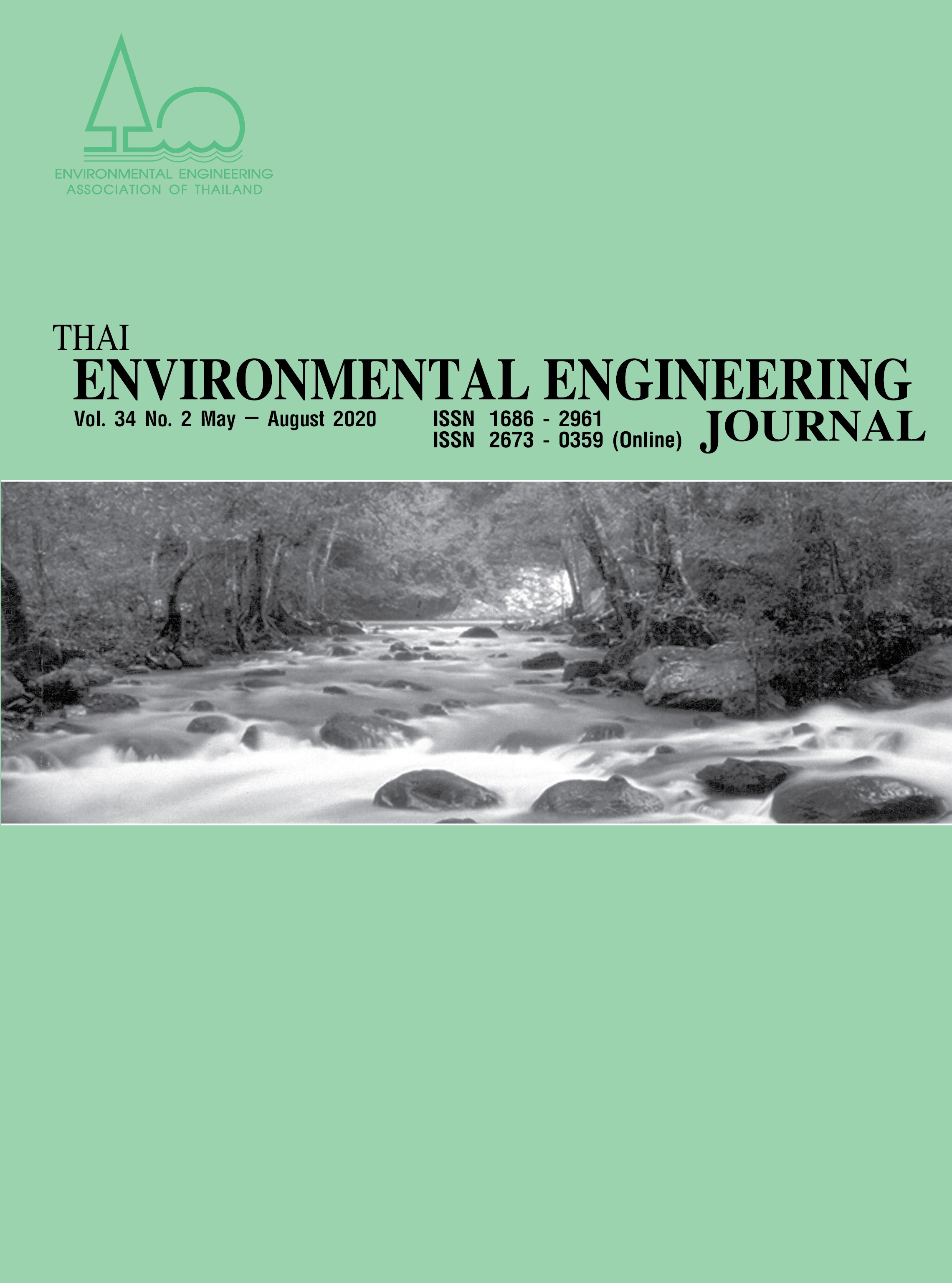Human-associated Escherichia coli Marker: Important Indicator to Evaluate River Water Quality and Treatment Ability of Surrounding Wastewater Treatment Plants
Main Article Content
Abstract
River water contamination can threaten human health because waterborne pathogens in environmental water can expose to humans via recreational activities. In addition, river water is an important source for water consumption in Thailand. Therefore, microbial source tracking has become a crucial method to evaluate the source of fecal contamination, water quality, and to understand the cause of fecal contamination by investigating the treatment ability of surrounding wastewater treatment plants (WWTPs) affecting the river water quality. In this study, 200 Escherichia coli isolates collected at four sampling sites around WWTPs of the Mae Klong River were tested with a human-associated E. coli genetic marker (H8) for evaluation the human fecal pollution in the river. Moreover, water quality parameters were measured at the same sites. The levels of H8 marker detection were also investigated with the ability of WWTPs among four sites along the river. Real-Time PCR was performed on the isolated samples with the H8 marker and the results showed that proportions of positive isolates increased at Mueang Kanchanaburi district (KP1: 46%) and Mueang Ratchaburi district (RP1: 38%). The positive proportions from all sites were significantly different between the locations (p < 0.001). Furthermore, the number of population and wastewater treatment plants capacity were relatively high in those areas (KP1 and RP1). This study showed that the H8 marker can be used as a crucial genetic marker for identifying the human-source contamination in water environment. Furthermore, it can be suggested that management of wastewater treatment system is a key to reduce human fecal pollution for better environmental water quality.
Article Details
References
Ahmed, W., Zhang, Q., Lobos, A., Senkbeil, J., Sadowsky, M., & Harwood, V. et al. 2018. Precipitation influences pathogenic bacteria and antibiotic resistance gene abundance in storm drain outfalls in coastal sub-tropical waters. Environment International, 116, 308-318.
Gyawali, P., Croucher, D., Ahmed, W., Devane, M., & Hewitt, J. 2019. Evaluation of pepper mild mottle virus as an indicator of human faecal pollution in shellfish and growing waters. Water Research, 154, 370-376.
Harwood, V., Levine, A., Scott, T., Chivukula, V., Lukasik, J., Farrah, S., & Rose, J. 2005. Validity of the Indicator Organism Paradigm for Pathogen Reduction in Reclaimed Water and Public Health Protection. Applied and Environmental Microbiology, 71(6): 3163-3170.
WHO. 2003. Guidelines for Safe Recreational Water Environments. Coastal and Fresh Waters. Volume 1. World Health Organization, Geneva, Switzerland.
Harwood, V., Staley, C., Badgley, B., Borges, K., & Korajkic, A. 2014. Microbial source tracking markers for detection of fecal contamination in environmental waters: relationships between pathogens and human health outcomes. FEMS Microbiology Reviews, 38(1): 1-40.
Khalil, A., Rittima, A., & Phankamolsil, Y. 2018. The projected changes in water status of the Mae Klong Basin, Thailand, using WEAP model. Paddy and Water Environment.
Gomi, R., Matsuda, T., Matsui, Y., & Yoneda, M. 2014. Fecal Source Tracking in Water by Next-Generation Sequencing Technologies Using Host-Specific Escherichia coli Genetic Markers. Environmental Science & Technology, 48(16): 9616-9623.
Warish, A., Triplett, C., Gomi, R., Gyawali, P., Hodgers, L., & Toze, S. 2015. Assessment of Genetic Markers for Tracking the Sources of Human Wastewater Associated Escherichia coli in Environmental Waters. Environmental Science & Technology, 49(15): 9341-9346.
Harada, H., Fujimori, Y., Gomi, R., Ahsan, M., Fujii, S., Sakai, A., & Matsuda, T. 2018. Pathotyping of Escherichia coli isolated from community toilet wastewater and stored drinking water in a slum in Bangladesh. Letters in Applied Microbiology, 66(6): 542-548.
Belanger L, Garenaux A, Harel J, Boulianne M, Nadeau E, Dozois CM. 2011. Escherichia coli from animal reservoirs as potential source of human extraintestinal pathogenic E. coli. FEMS Immunol Med Microbiol. 62: 1-10.
Nopprapun, P., Boontanon, S. K., Harada, H., & Fujii, S. 2020. Human Source Identification by Using a Human-Associated Escherichia coli Genetic Marker in Mae Klong River, Thailand.
Domestic wastewater treatment plant in Thailand. 2018. Pollution Control Department. Retrieved 13 September 2019, from http://www.pcd.go.th/
Water quality standards of surface water in Thailand. 2000. Pollution Control Department. Retrieved 5 October 2019, from http://www.pcd.go.th/info_serv/reg_std_ water05.html
Mae Klong River Basin. 2012. Hydro and Agro Informatics Institute (Public Organization) Retrieved 26 November 2019, from http://tiwrmdev.haii.or.th/web/attachments/25basins/14-maeklong.pdf
Odagiri, M., Schriewer, A., Hanley, K., Wuertz, S., Misra, P., Panigrahi, P., & Jenkins, M. 2015. Validation of Bacteroidales quantitative PCR assays targeting human and animal fecal contamination in the public and domestic domains in India. Science of the Total Environment, 502, 462-470.
Somnark, P., Chyerochana, N., Mongkolsuk, S., & Sirikanchana, K. 2018. Performance evaluation of Bacteroidales genetic markers for human and animal microbial source tracking in tropical agricultural watersheds. Environmental Pollution, 236, 100-110.
The number of livestock in Kanchanaburi province. 2014. Kanchanaburi Provincial Livestock Office. Retrieved 11 August 2019, from http://pvlo-knr.dld. go.th/index2.html
The number of livestock in Ratchaburi province. 2015. Ratchaburi Provincial Livestock Office. Retrieved 11 August 2019, from http://pvlo-rri.dld. go.th/index.php/en/livestock-list-ratchaburi
The Number of population along Mae Klong River. 2018. Department of Provincial Administration. Retrieved 5 October 2019, from https://www.dopa.go.th/main/web _ index
Wastewater treatment plant in Kanchanaburi. 2019. Kanchanaburi Municipality Office. Retrieved 25 December 2019, from http://www.muangkan.go.th/
Wastewater treatment plant in Ratchaburi. 2019. Ratchaburi Municipality Office. Retrieved 25 December 2019, from http://www.rbm.go.th/index.php
Ballesté, E., Demeter, K., Masterson, B., Timoneda, N., & Meijer, W. 2019. Implementation and Integration of Microbial Source Tracking in a River Watershed Monitoring Plan.
Jardé, E., Jeanneau, L., Harrault, L., Quenot, E., Solecki, O., & Petitjean, P. et al. 2018. Application of a microbial source tracking based on bacterial and chemical markers in headwater and coastal catchments. Science of the Total Environment, 610-611, 55-63.


